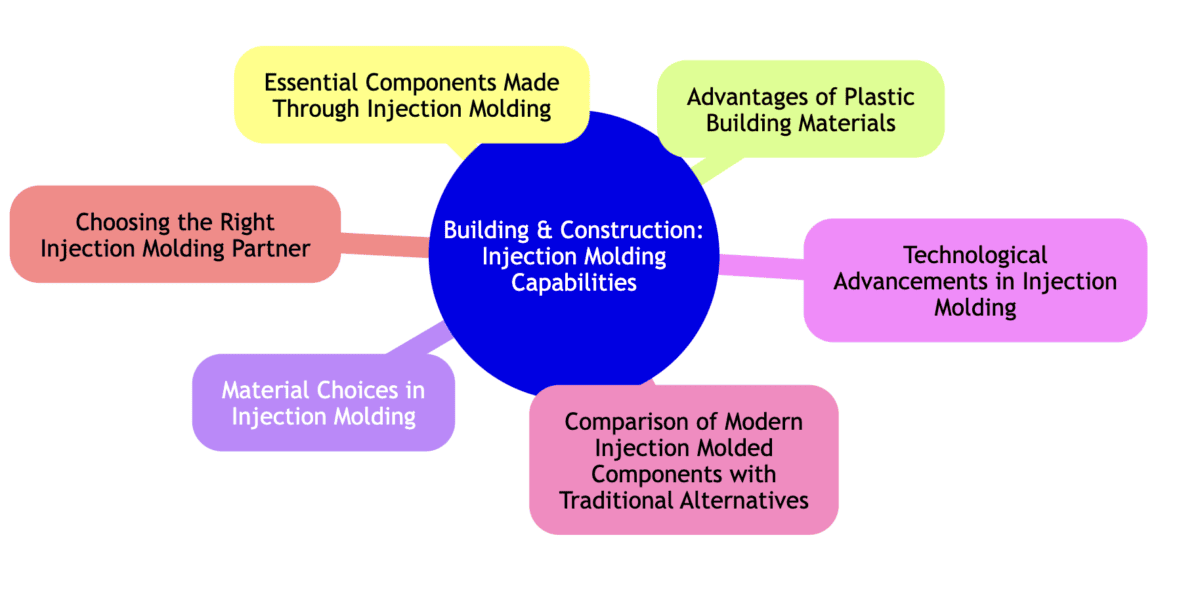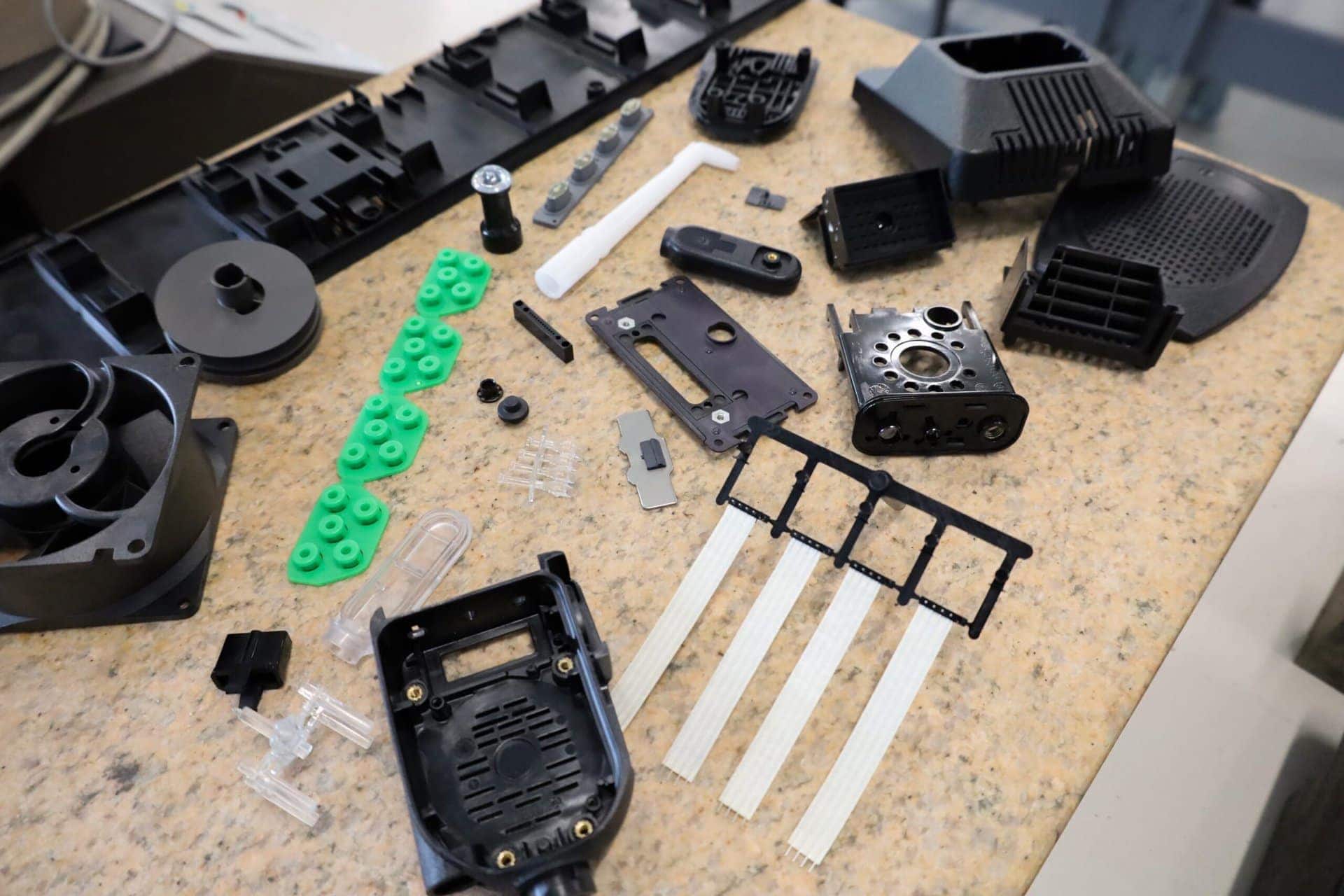Introduction to Injection Molding in Construction
There are endless applications for injection molding in the construction industry.
Frames, insulation, fixtures, pipes, tools, tool boxes, boom boxes… The list goes on and on.
The building and construction industry shapes our lives, meaning the injection molding companies supporting builders are equally as impactful.
JDI Plastics is an injection molding company dedicated to quality and efficiency. We invite you to use this blog as a resource to better understand injection molding and its impact on building and construction.
Key Takeaways
- Versatility: Injection molding can produce a variety of complex shapes and sizes, perfect for construction needs.
- Cost Efficiency: Lower production costs due to automation and reduced waste.
- Speed: High-speed injection molding production means faster project completion times.
- Durability: Molded plastic parts are resistant to corrosion, reducing maintenance needs.
- Sustainability: Many plastics used are recyclable, supporting eco-friendly construction practices.

Essential Components Made Through Injection Molding
In the construction industry, injection molding is instrumental in creating critical components that ensure structures are sturdy, cost-efficient, and aesthetic.
Injection-molded plastics are becoming increasingly prevalent. Applications include ornate window frames that offer functionality and style to insulation materials that improve energy efficiency.
Common Injection Molded Components in Construction
- Window Frames: Enhance thermal insulation and reduce assembly costs.
- Insulation Materials: Improve energy efficiency and comfort in buildings.
- Plumbing Components: Corrosion-resistant and less prone to leakage than traditional materials.
- Lighting Fixtures: Customizable and lightweight options for modern designs.
- Decorative Elements: Durable and intricate designs made possible with versatile plastic materials.
Advantages of Plastic Building Materials
Plastic materials used in construction bring several substantial benefits, most notably their cost efficiency, durability, and customization flexibility.
Firstly, plastics offer significant cost savings, not only in terms of initial material expenses but also by reducing the ongoing maintenance costs associated with more traditional materials like wood and metal, which may corrode or degrade over time.
Moreover, plastics’ inherent durability, when exposed to various environmental stressors such as moisture, chemicals, and UV radiation, makes them an excellent choice for long-lasting construction projects. This resilience extends the lifecycle of building components like piping systems or exterior cladding.
They hold up well over time without requiring frequent replacements or repairs.
Additionally, the ease of customization with plastics is unparalleled. Thanks to modern injection molding techniques, plastics can be molded into complex, precise shapes that meet specific architectural demands. This ability allows for creating tailored components that fit exact construction needs, enhancing buildings’ functionality and aesthetic appeal.
The flexibility of design with plastics not only supports innovative construction practices but also caters to a broad spectrum of applications, from practical elements like insulation panels to intricate decorative features.
Material Choices in Injection Molding
ABS (Acrylonitrile Butadiene Styrene)
ABS is a popular choice in construction for its high-impact resistance and robustness. It’s particularly favored for items that require toughness and precise dimensional stability, making it ideal for fittings and fixtures that must endure heavy use.
Polyamide (Nylon)
Known for its strength and thermal resistance, Nylon is another excellent material for construction-related injection molding. Its ability to resist wear and abrasion makes it suitable for high-load elements like support brackets and door handles.
Polypropylene
Polypropylene is celebrated for its chemical resistance and flexibility, often used in applications where a lesser degree of rigidity might be beneficial. It’s commonly found in less structurally demanding parts, such as ductwork components and temporary floor coverings. (1)
Technological Advancements in Injection Molding
The realm of injection molding has seen significant technological advancements, enabling the creation of better and more reliable construction components. Automation in molding processes has significantly increased the production rates and consistency of quality in manufactured parts. Advanced mold design technologies have also allowed for greater complexity in part designs, which was previously impossible.
Steps in the Modern Injection Molding Process
- Design Conceptualization: Utilizing CAD software to draft and refine the component’s geometry.
- Material Selection: Choosing the appropriate plastic material based on the component’s required properties.
- Mold Tooling: Creating the mold to form the plastic parts.
- Molding: The actual process of injecting molten plastic into the mold.
- Cooling and Ejection: Allowing the part to cool and then ejecting it from the mold.
- Post-processing: Including trimming, painting, or any other finishing touches to the part.
Comparison of Modern Injection Molded Components with Traditional Alternatives
| Component | Traditional Material | Specific Plastic Types | Benefits of Modern Materials |
| Window and Door Components | Wood or metal | Polyvinyl Chloride (PVC), Polypropylene (PP) | Enhanced durability, weather resistance, lower maintenance |
| Insulation Housings | Various degradable materials | Expanded Polystyrene (EPS), Polyurethane | Improved sealing, thermal retention, resistance to moisture and pests |
| Plumbing Fixtures | Metal prone to corrosion | Polyethylene (PE), Polypropylene (PP) | Precision fit, durability, reduced leakage and maintenance |
| Lighting Fixtures | Glass or metal | Polycarbonate (PC), Acrylic (PMMA) | Lightweight, durable, design flexibility, heat resistance |
| Structural Connectors | Heavy metal | High-Density Polyethylene (HDPE), Nylon | Strong yet lighter, corrosion-resistant, easier installation |
| Roofing Components | Traditional shingles | Thermoplastic Polyolefin (TPO), PVC | Improved lifespan, resistance to weather, easier installation |
| Electrical Conduits | Metal | PVC, High-Density Polyethylene (HDPE) | Non-conductive, flexible, corrosion resistant |
| Decorative Exterior Trims | Wood, metal | Polyurethane, PVC | Weather-resistant, aesthetically flexible, low maintenance |
Choosing the Right Injection Molding Partner
The success of incorporating injection molded components in construction heavily depends on the expertise of the molding partner. Selecting a qualified partner ensures not only the quality but also the innovation necessary for your projects.
- Certifications: Look for ISO and other industry-specific certifications that affirm quality standards.
- Experience: Choose a partner with a proven track record in your industry.
- Technological Capability: Ensure they have state-of-the-art technology for design and production.
- Customization Abilities: Ability to tailor solutions to specific project needs.
- Quality Control Procedures: Comprehensive quality assurance processes are critical.
- Customer Service: Responsive and proactive customer support.
Final Thoughts – Injection Molding in Construction and Building
Injection molding has dramatically shaped the building and construction industry by offering versatile, robust, and cost-effective solutions. The precision and efficiency provided by this technology enable the creation of components that meet the stringent demands of modern construction projects.
JDI Plastics is proud to offer industry-leading injection molding services across many industries. We push the boundaries of injection molding to deliver customized, innovative solutions. With a commitment to quality and customer satisfaction, JDI Plastics is your go-to partner for reliable and effective construction components.
Visit our HOMEPAGE today for more resources!
Reference:
(1) Improve-Your-Injection-Molding, Mold Material, https://www.improve-your-injection-molding.com/mold-material.html

